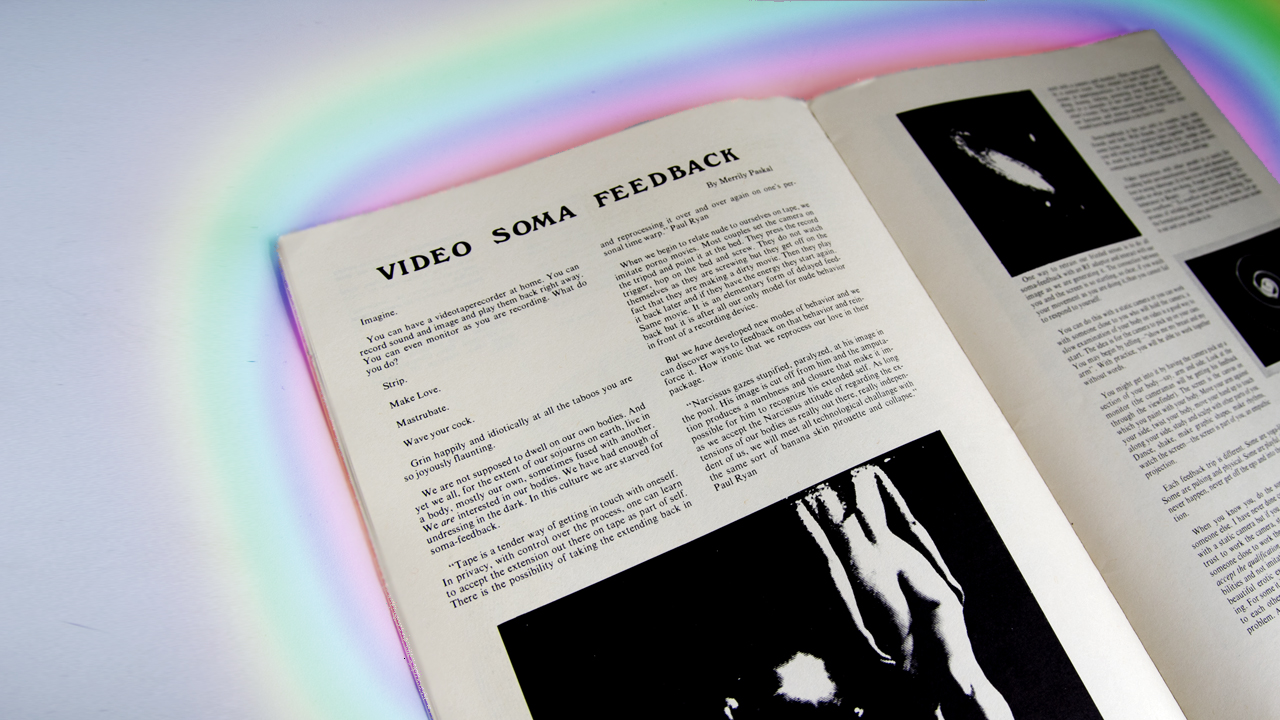ANIMAL’s Radicals Of Retrofuturism uncovers stories by the technological rebels of the past in vintage media and looks at their predictions in the context of today’s digital world. This week, we take a look at Merrily Paskal’s “Video Soma-Feedback” in Radical Software circa 1972.
Imagine.
You can have a videotaperecorder at home. You can record sound and image and play them back right away. You can even monitor as you are recording. What do you do?
Strip.
Make Love.
Masturbate.
Wave your cock.
Grin happily and idiotically at all the taboos you are so joyously flaunting.
We are not supposed to dwell on our own bodies. And yet we all, for the extent of our sojourns on earth, live in a body, mostly our own, sometimes fused with another. We are interested in our bodies. We have had enough of undressing in the dark. In this culture are starved for soma-feedback.
In 1969, Michael Shamberg founded the Raindance Corporation, a collective of artists who were beginning to use home video equipment in experimental and political ways. Later, Shamberg would go on to become a successful Hollywood producer, with credits on films like A Fish Called Wanda and Pulp Fiction. But in 1972, he was editing the briefly-lived publication Radical Software, a journal that published a combination of media theory, poetry and art by those interested in the burgeoning field of DIY video recording. Its contributors included artist, Marshal McLuhan‘s assistant and “guerilla television” proponent Paul Ryan and “father of video art” Nam June Paik.
David A. Ross, the former director of the Whitney and the SFMoMA, summarized the climate in which the publication came into being:
[The artists] understood, through their reading of Buckminster Fuller, Gregory Bateson and Marshall McLuhan, that what needed changing was not the machines, but the instructions used to operate them. The social implications were evident: radical hardware was fine but what was critically needed was Radical Software.
In the fifth issue of the journal published in spring of 1972 (available in full here), Merrily Paskal, a member of the early ’70s Vancouver experimental art collective the Intermedia Society, contributed a piece entitled “Video Soma-Feedback.” Paskal asked the readers to imagine their reaction to watching themsevles on film in real time.
She quotes from fellow artist Paul Ryan:
Tape is a tender way of getting in touch with oneself. In privacy, with control over the process, one can learn to accept the extension out there on tape as part of self. There is the possibility of taking the extending back in and reprocessing it over again on one’s personal time warp.
Though some would characterize the technological trick described here as intrusive, dehumanizing or narcissistic, Paskal saw in it the opposite. She advocated lovingly observing our own bodies without shame – a view that fits with both the flower children of her time and those who now use web-mediated images to represent their truer selves. “We have had enough of undressing in the dark,” she writes. Her fantasy encompasses much of what makes up our interpersonal communications today, from FaceTime to selfies to video game avatars.

“The screen is the canvas on which you paint with your body,” she wrote. “The screen is part of you, an empathic projection.” This flew against the prevailing wisdom of the time, that television was a corrosive medium dumbing us down and separating us from the natural world.
While critics of digital culture still warn we are distancing ourselves from “real” human interaction, “Video Soma-Feedback” was intended to increase intimacy with those around us through the screen’s mirror. After getting to know yourself through real-time video, Paskal recommended experimenting with someone else. She acknowledged that it might be hard to relate to the video and another person simultaneously, but she had a solution: “A man and a woman… in separate rooms, each with a camera and monitor… connected by a control room.” She even thought that this set up could increase the sensuality of the encounter.
 Interactions like these are just a regular part of our lives today. Many of us are separated from some of the most important people in our lives by both geological distance and a screen. Partners and families who live across the world from each other use video calls to feel each others presence. A massive porn industry has arisen to accommodate people with access to screens and webcams but not necessarily another physically present human.
Interactions like these are just a regular part of our lives today. Many of us are separated from some of the most important people in our lives by both geological distance and a screen. Partners and families who live across the world from each other use video calls to feel each others presence. A massive porn industry has arisen to accommodate people with access to screens and webcams but not necessarily another physically present human.
Forty years after “Video Soma-Feedback” was published, we are still negotiating the reality of our increasingly split identities. Through social media, we now fragment ourselves into countless pieces for different platforms and audiences, and often get into trouble trying to manage them. Attempting to make ourselves whole again through the use of self-surveillance sounds futuristic even now, though we have made progress using strategies like these to treat victims of PTSD, among others. The stability of our self-perception is shakier now than it was in the time of Radical Software. But perhaps when the “Me Me Me” generation looks into the webcam’s eye, they see more than their critics imagine. As someone once said, “know thyself.”


